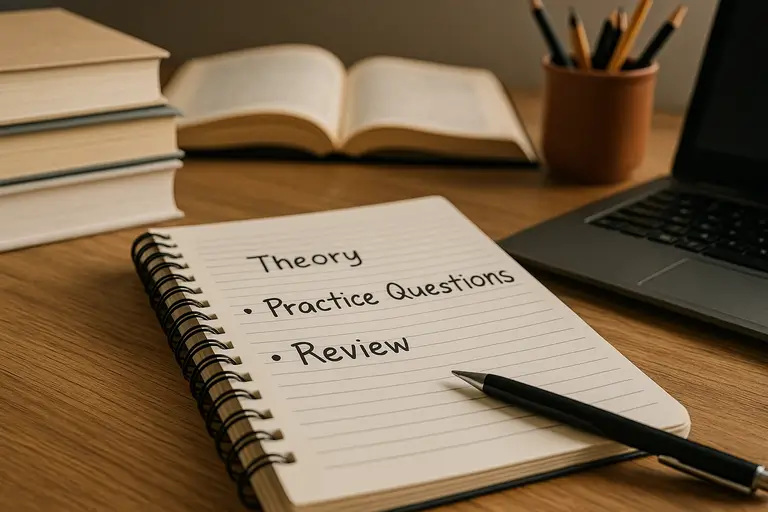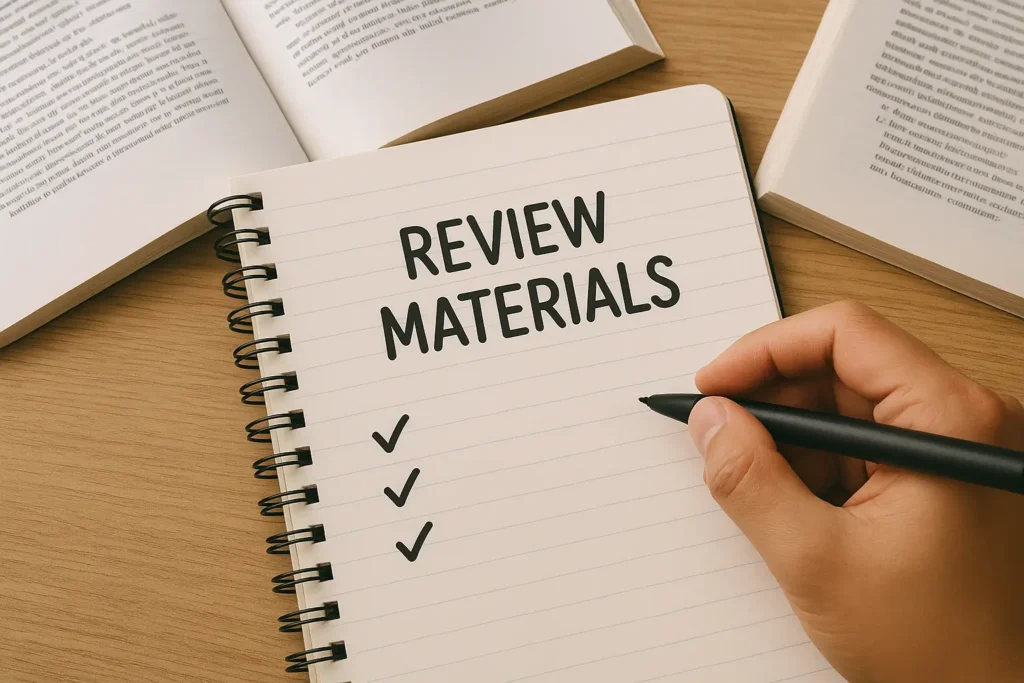
One of the biggest challenges for anyone preparing for a public exam is finding the right balance between theory, practice, and review. Should you spend more time learning new content or solving questions? When is the right moment to start revising? And how much of your study routine should be dedicated to each of these phases? These questions can create a lot of confusion — and sometimes, paralysis.
Many candidates fall into one of two traps: they either focus too much on theory and postpone practice until “later,” or they dive into solving questions without having built a solid foundation. Both strategies can lead to frustration. The truth is that each of the three elements — theory, questions, and review — plays a unique and essential role in your learning process.
In this article, you’ll learn how to divide your study time strategically among these three pillars. Whether you study full-time or just a few hours per day, these principles will help you make the most of your time and build a more effective, sustainable routine that moves you closer to your approval.
Start With the Right Focus: Build a Strong Theoretical Foundation
Theory is the base of everything. Without a good understanding of the material, no amount of practice will make you truly confident. That’s why, especially at the beginning of your preparation or when starting a new subject, you should prioritize theory. Reading the material, watching quality video classes, and making your own notes are key to building a solid understanding.
However, studying theory doesn’t mean trying to memorize everything in one go. Your goal should be to understand the logic of the subject and create mental maps that connect key concepts. Don’t get stuck in the illusion of “perfect learning” before moving on — comprehension is more important than memorization at this stage.
If you’re studying for several hours a day, consider dedicating 40–50% of your time to theory in the early stages. For those with limited time, try to ensure that at least one block of study per day is focused on understanding new content. As your knowledge grows, this percentage can be reduced to make space for practice and review.
Integrate Practice Questions Early — Don’t Wait Too Long
A common mistake is to study theory for weeks or even months before attempting practice questions. This is counterproductive. Practicing is not something that should be postponed — it’s something that should be integrated from the beginning. Practice helps reinforce learning, identify gaps, and develop the ability to apply content under pressure.
Solving questions forces your brain to recall and apply information, which is far more powerful than passive reading. It also familiarizes you with the style of the exam and helps you learn how questions are typically asked. You’ll start recognizing patterns, common traps, and recurring topics that appear in multiple exams.
Ideally, as you finish each topic or subtopic, immediately follow it up with 5–10 practice questions. This keeps the content fresh and strengthens retention. As your preparation progresses, increase the number of questions per study session and allocate 30–40% of your time to practice — adjusting based on how well you’re performing.
Make Review a Core Part of Your Routine

Review is what turns short-term learning into long-term knowledge. Without frequent and structured review, you’ll forget most of what you studied — no matter how well you understood it at the time. That’s why review must be a regular and strategic part of your schedule, not something you do “when you have time.”
There are many effective methods to review, including spaced repetition, flashcards, rewriting notes, reviewing error logs, and summarizing topics out loud. The most effective reviews are active, meaning they involve retrieving information rather than simply rereading. Try to recall what you studied before opening your notes — this strengthens memory.
Depending on your stage of preparation, aim to dedicate at least 20–30% of your weekly study time to review. In the final months before the exam, this percentage may increase even more, since the focus shifts from learning new content to consolidating and refining what you already know.
Adjust the Balance Based on Your Preparation Stage
The right time division isn’t fixed — it depends on where you are in your study journey. At the beginning, when everything is new, it’s natural to focus more on theory. But as time goes on, your study routine should shift toward more practice and more review, while reducing the time spent on new content.
Here’s a basic example of how you can adjust your time:
- Beginner level (first 2–3 months):
- 50% theory
- 30% practice
- 20% review
- Intermediate level (3–6 months):
- 35% theory
- 40% practice
- 25% review
- Advanced level / Final stretch (last 1–2 months before exam):
- 20% theory
- 40% practice
- 40% review
These numbers are not rigid rules, but they provide a flexible framework to help you shift your focus according to your needs. Always be ready to adjust based on your performance, difficulties, and the specific requirements of your exam.
How to Organize Your Study Sessions in Practice
To apply this balance day-to-day, organize your study blocks based on focus and energy. For example, if you study in the morning when your brain is fresher, that’s a great time for learning new theory. In the afternoon or evening, when you’re more mentally tired, focus on practice or review, which are often more active and dynamic.
Another good approach is to use study cycles instead of rigid daily subjects. For example, over a 3-day period, you might cover 6 subjects, each with a balance of theory, questions, and review. This avoids overload and creates a more organic learning rhythm.
Also, keep track of your progress. Use a planner, spreadsheet, or app to mark what you studied, what you practiced, and what you reviewed. This tracking system gives you clarity, helps you identify gaps, and ensures that you’re moving forward in all areas — not just consuming new content endlessly.
Avoid Common Mistakes That Unbalance Your Routine
Some candidates believe that they need to master all theory before even touching questions. This mindset leads to overconfidence in content that hasn’t been tested, and it delays the development of exam techniques. On the other hand, doing only questions without understanding the theory can lead to shallow knowledge and frustration.
Another mistake is neglecting review. It may seem like “wasted time” compared to learning something new, but it’s review that actually locks in your progress. Without it, your preparation becomes a cycle of learning and forgetting, which wastes time and energy.
Finally, don’t forget to evaluate your strategy regularly. If your performance in practice questions is low, maybe you need more review — not more theory. If you feel stuck even after reviewing, it could be time to revisit the foundation. Be flexible, honest, and strategic with your time.
Final Thoughts: Balance Is the Secret to Progress
Studying for a public exam isn’t just about studying a lot — it’s about studying intelligently. Knowing how to divide your time between theory, questions, and review is one of the most important skills you can develop. With the right balance, you avoid overwhelm, reduce mental fatigue, and make consistent progress.
Each component of your routine plays a role: theory builds understanding, practice builds application, and review builds memory. Ignoring any one of them can limit your growth. Integrating them in the right proportions transforms your study into a structured, high-performance process.
So take a moment to reflect: how are you currently dividing your time? What needs to shift to unlock the next level of your preparation? Balance isn’t static — it evolves with you. And when you find it, real improvement begins.